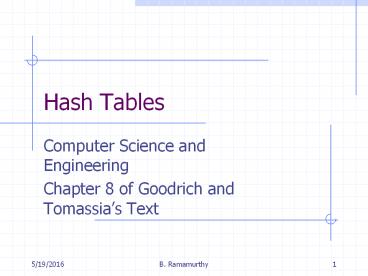Hash Tables PowerPoint PPT Presentation
Title: Hash Tables
1
Hash Tables
- Computer Science and Engineering
- Chapter 8 of Goodrich and Tomassias Text
2
Topics
- Hashing
- Hash functions
- Hash Tables
- Collision
- Collision resolution
- Chaining, linear probing, quadratic probing,
double hashing - Java Hash table
- Example
3
Hashing Concept
- Another approach for storing and searching
elements. - Used in applications where add and delete,
besides search, are used. - Worst case linear but can get O(1) best case.
4
Hash Function
- A hash function h maps keys of a given type into
an integer interval 0, N-1 - A simple function
- h(x) x mod N
- A good hash function will uniformly disperse the
keys in the range 0, N-1
5
Hash Table
- Hash table ADT
- Has a hash function h
- Array of size N
- Collision occurs when two keys map to the same
array index. - Two major collision resolution schemes are
chaining and open addressing
6
Example
- Item(name, ssn) where ssn is 9 digit positive
integer. - Hash table N 10000.
- Hash function last four digits of of x
- Use chaining to handle collision.
7
Hash Table Example
0 1 2 3
045-34-0002
. . . .
9996 9997 9998 9999
567-34-9996
045-35-9996
8
Hash Functions
- Usually specified as two components
- Component1 called the hash code map, collects the
parts of the data and maps them to integers
(numeric data) - H1 keys ? integers
- Component2 called the compression map, takes the
integers and maps them to 0 to N-1. - H2 integers? 0, N-1
9
Hash Code Maps
- Memory address of data
- Integer cast of non-numeric data bit/byte
pattern of data - Sum of all components add the ascii values of
your last name - Polynomials of various parts of data.
10
Compression maps
- Reminder of division (mod)
- h(y) y mod N
- Multiple, Add and Divide (MAD)
- h(y) (ay b) mod N where
- a mod N ltgt 0 (otherwise everything will map to
b!)
11
Linear Probing
- Linear probing resolves collision by placing the
colliding item in the next available empty cell. - Each entry inspected is referred to as the
probe - Example h(x) x mod 13
- Insert keys 18, 41, 22, 44, 59, 32, 31, 73, in
that order
12
Search with linear probing find(k)
- j h(k) probe 0
- while (p lt N)
- 2.1 c Aj
- 2.2 if (c null) return NOT_FOUND
- else if (c.key() k)
- return c.element()
- else j (j1) mod N
- p p 1
- 3. return NOT_FOUND
13
Double Hashing
- h1 primary hash function
- If it results in collision, resolve by applying
another hash function, secondary hash function
here is an example of such a function. - d(k) q k mod q
- Where q lt N,
- Possible values of d(k) are 1,2,3,..q
- It cannot be 0
- When collision occurs (h(k)jd(k)) mod N
- j 0, 1, ..N-1
14
Example
- h(k) k mod 13
- d(k) 7 k mod 7
- Insert 18, 41, 22, 44, 59, 32, 31, 73.
15
Java support for Hashing
- Java1.4 API
- Hashtable since jdk1.0
- HashMap since jdk1.2
16
Hashtable/HashMap
- Array of Entry
- Chaining is the collision resolution policy
- Entry is an inner class Entry is a list
- Entry holds a key, value and a link to next Entry
- Key Object should implement hashcode() and
equals() methods - hashcode() of the Key class is the hash code map
that converts key attributes to an integer - Compression map/function is hashcode mod
array.length - Loadfactor (how full it can get before
expanding), initial capacity can be specified
17
Hashtable vs HashMap
AbstractMap
extends
Hashtable Map, Cloneable,
Serailizable
implements
18
Hashtable vs HashMap
- Hashtable implements Dictionary which is
deprecated and has been superceded by AbstractMap - Hashtable implementation is a synchronized for
concurrent access. HashMap leaves synchronization
to the application. - Hashtable is slower (due to synchronized
implementation)
19
HashMap
20
Using HashMap
- Problem Consider employee data that has last
name, first name, employee number (5 digit
integer), and salary. We want to maintain a data
structure of 100 temporary employees for easy
add, remove and search. - Solution HashMap
21
Using HashMap
- Problem An employee data is made up of Name
(first, last), employee number (Integer), and
salary. Maintain a set of 50 employee data for a
temp agency so that employees can be added,
removed and searched easily. - Solution Choice of data structure HashMap
- Key? Lets consider employee number as key in the
first version - In the second version we will consider name as
the key - Name is a class of two attributes first, last
22
TempAgency Design
23
More hashCode() method
- hashCode() is predefined in Object class for all
classes. - The default value that hashCode() returns is the
memory address of the object. - Where is hashCode() called in the HashMap?
- In the put(), get(), remove() and others that
compute the hash index in the two phase hashing
(hash code map and compression map)
24
Summary
- Hashing offers a convenient way to store and
search for data. - The data considered in the form of key, value
pair. - The location of a data depends only on its key,
not on its successor and/or predecessor key.

